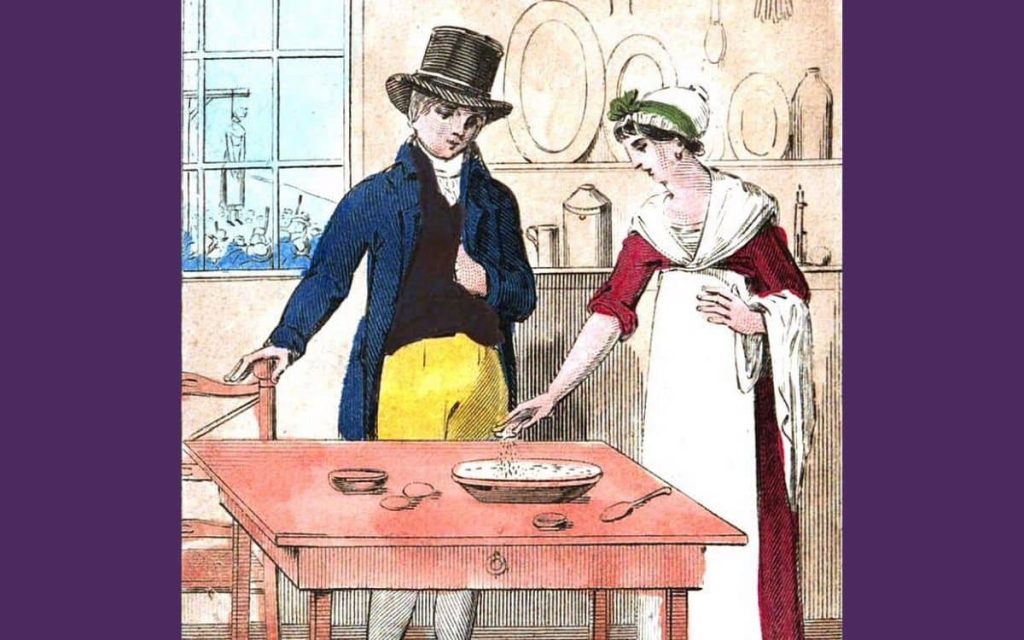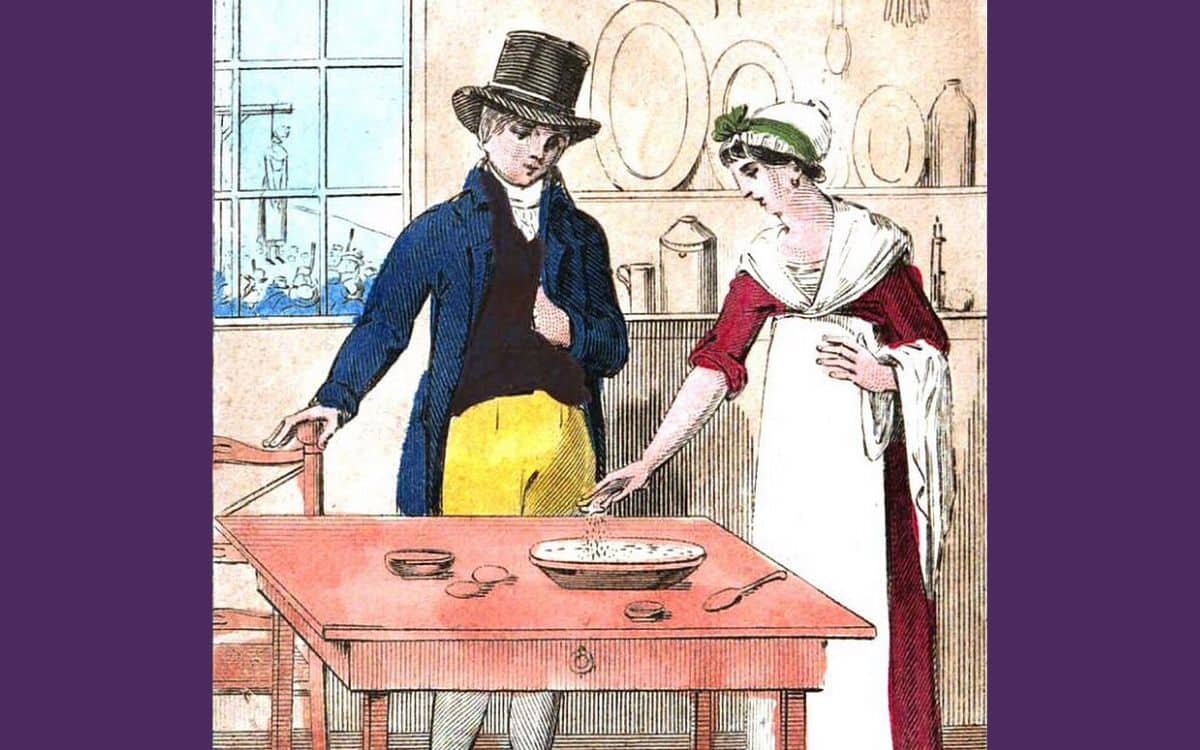Mary Bateman was a self-styled Yorkshire witch who robbed her clients until her dark schemes led her to the gallows, writes guest writer HUNTER MATTACKS
On 20 March 1809, Mary Bateman was executed at York Castle. The gallows faced out over St George’s Field and the stately flow of the River Ouse. Her reputation was well known across the North and West Ridings, and the reports for that day gleefully declared that she was forfeiting her life on account of being found guilty of witchcraft.
But the laws that had been used to execute people during the witch crazes of the 17th century had been repealed in 1736. Mary had actually been found guilty of a far more prosaic crime, that of good old fashioned murder.
So, was the press just repeating hyperbole and rumour, or was there something else in the claims of the Yorkshire Witch? Whisperings were no doubt swirling, but, intriguingly, they mostly seem to have been conjured up by Mary herself.
What was Mary Bateman?
Mary was born Mary Harker in 1768 to a farming family just outside of Thirsk. Her first brush with the darker side of life appears to have been when she was around 13 years old. She had taken a job in service in a household in York but it didn’t last long. She was implicated in a theft and rather than risk the potentially deadly consequences of being caught she slipped away from the city and resurfaced in Leeds.
By the time she was 15 she was working as a mantua maker in Leeds’ famous textiles industry and had married John Bateman, a wheelwright.
Both skilled trades would probably have provided enough for the couple to get by, but Mary began to look around for other ways to supplement their income.
Opportunity soon came in the form of a tragic fire in the nearby Leeds suburb of Holbeck. Mary went door to door claiming she had lost a child in the fire and begging for money to pay for a burial or cloth to use as a winding sheet. She promptly sold the cloth to a pawnbroker and pocketed the money.
But even in the late 18th century industrial accidents were not reliable enough to provide a steady income. Mary had recently become interested in the work of Joanna Southcott who was gathering a following up and down the country with her apocalyptic visions and religious prophecies. Mary, inspired by Joanna, began advertising her skills as a fortune teller.
A Crime Most Fowl
She claimed to have a chicken that could predict the future. The remarkable bird would lay eggs with prophecies and religious sayings engraved on them. The most common message was the helpfully ambiguous ‘Christ is Coming’. She would charge a penny for people to witness this incredible feat.
Disturbingly, the most likely explanation for this miracle is that Mary was engraving the freshly laid eggs herself then inserting them back into the chicken.
Not only does this sound eye wateringly painful for the poor thing, but begs the question how her neighbours didn’t know what going on. Chickens are famously not quiet animals.
As well as poultry that could predict the future Mary made money selling charms and potions. These charms often involved money that Mary would take from her clients and work into bags and amulets to either be worn on the person or kept somewhere significant in the home.
She also claimed to act as an agent for two other ‘wise women’, Mrs Moore and Mrs Blyth, who lived ‘some distance away’. Mary would take payment on behalf of her friends as well as any postage incurred for the letters she sent on to them.

These small side hustles served Mary well, but she was ever on the look out for bigger prizes. In 1807 she made the acquaintance of William and Rebecca Perigo.
Initially she sold them the charms and prophecies that had been so popular with her other clients, and if she had been content to continue in the same vein it is likely that no one today would know the name Mary Bateman and she would not have faced the noose on that March morning in York.
Mary, once again, saw an opportunity. She told the couple that she’d had a dreadful premonition. She had seen in a vision that they would both be struck down with a terrible illness within weeks if they did not take the prophylactic remedy that she had made for them. She gave them a powder and very strict instructions on how it should be taken.
They must eat the entirety of whatever food they mixed the powder in with (Mary suggested puddings) and not, under any circumstances, allow any other person or animal to consume the food.
No matter what happened they were not to call for a doctor. They must repeat this every day for a week and then she would return, hopefully having had further divine guidance on what do next.
By William Perigo’s account the first six doses passed without incident, but the seven dose affected the taste of the food so badly he couldn’t finish it.
Rebecca, sadly, was terrified of the death Mary had foretold and forced herself to finish both the pudding, and the honey tincture Mary had given them to take in case of any unpleasant side effects. Within a week she was dead, writhing in agony as the poison worked its way through her.
If Mary had been calculating and cold blooded before, her response to Rebecca’s death was nothing short of chilling. She insinuated to William that his failure to follow her instructions had caused her remedy not to work on his wife. It was God’s punishment for his doubt.
She convinced him to continue to buy her charms and potions to stave off his own demise, not to mention the guilt at his wife’s death.
This dreadful charade went on for nearly a year. Eventually William’s funds were so depleted that, in desperation, he opened the charms Mary had made for him to use the money inside them. To his horror he found nothing but scrap paper and a few dried herbs inside. Heartbroken, he forced himself to go to the magistrate and report Mary.
Arrested for murder and executed
Mary was arrested in October 1808. A white powder was found on her that turned out to be a mercury preparation. This was the ‘remedy’ that had killed poor Rebecca.
Leeds was still a relatively small town despite its burgeoning industry so she was sent to York where she was tried at the next assizes in March 1809. She was found guilty and swiftly committed for execution.
But Mary’s story did not end there. Her notoriety, first as a wise woman and then as a murderess, had gripped Yorkshire. After she was executed her body was returned to Leeds and 5000 people lined the route to watch her journey home.
She was taken to the newly opened Leeds General Infirmary. This was the era when medical students could only use executed criminals for their anatomy practicals, but the Infirmary knew Mary was worth much more to them intact.
The surgeons displayed Mary’s body in the hospital and charged people three pennies to see her. They made a very tidy profit of £30 (£3000 in today’s money) and when her body had decayed too far to be displayed Dr William Hey publicly dissected her.
After the event he sold off 100 strips of her skin. The remaining cunning folk of Leeds got hold of as many of them as they could and tanned them into leather to make their own charms.
Mary Bateman’s Witchy Legacy
Mary’s story wasn’t over yet. She was displayed at the Thackray Medical Museum just outside Leeds city centre and entertained generations of visitors.
In 2015 the museum took the decision to no longer use human remains in their exhibits and a great deal of work was undertaken to contact relatives and lay remains to rest in a respectful way. Unsurprisingly no one claimed Mary so her skeleton (now mysteriously missing her feet and legs below the knee) was offered to the University of Leeds.
Not really knowing what else to do with her they took her to the morgue at the University’s medical school where she now rests, surrounded by the cadavers used to train Leeds’ next generation of doctors.
Have you seen or experienced anything connected to Mary Bateman? Tell us about it in the comments section below.

fascinated with the dark tales of our past, especially those of the North Country, and how sometimes we need ghosts to help us tell and understand these stories. Spooky Isles is her first adventure in non-fiction writing.



